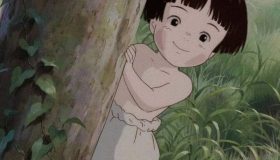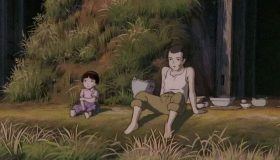
Studio Ghibli’s Grave of the Fireflies (1988) stands as one of the most poignant and haunting animated films ever made. Directed by Isao Takahata, this Japanese wartime drama is a harrowing tale of survival, love, and the human cost of war. It’s a story that lingers in the heart and mind long after the credits roll, showcasing the incredible power of animation as a medium for storytelling.
This article explores the making of Grave of the Fireflies, its artistic and narrative brilliance, its emotional depth, and its enduring legacy in the world of cinema.
Overview of the Film
Plot Summary
Grave of the Fireflies tells the heartbreaking story of two siblings, Seita and Setsuko, as they struggle to survive during the final months of World War II in Japan. After losing their mother in a bombing raid and being separated from their father, Seita and his younger sister, Setsuko, are left to fend for themselves. Their journey, filled with moments of tenderness and tragedy, is a sobering depiction of the toll war takes on the innocent.
The film opens with Seita’s spirit narrating his death, immediately setting the tone for a reflective and melancholic tale. What follows is a non-linear recounting of their hardships, from living with an uncaring aunt to seeking refuge in an abandoned shelter. The metaphor of fireflies—beautiful yet fleeting—runs throughout the film, symbolizing both the fragility of life and fleeting moments of hope in dark times.
Making of Grave of the Fireflies
The Genesis of the Film
Isao Takahata drew inspiration for Grave of the Fireflies from Akiyuki Nosaka’s semi-autobiographical novel of the same name. Nosaka’s story, published in 1967, was based on his own experiences during the war, including the loss of his younger sister to malnutrition. The raw emotional power of Nosaka’s prose deeply resonated with Takahata, who sought to translate this tragedy into a film.
The idea of adapting such a dark and realistic story into an animated film was unconventional. At the time, animation was largely associated with fantasy, children’s entertainment, or lighthearted narratives. Takahata’s choice to use animation for a story so rooted in realism was revolutionary, proving that the medium could convey profound human emotions and societal commentary.
Studio Ghibli’s Role
Although Studio Ghibli had already gained acclaim for Hayao Miyazaki’s Nausicaä of the Valley of the Wind (1984) and My Neighbor Totoro (1988), Grave of the Fireflies marked a departure from its more fantastical storytelling. The film was released as a double feature with My Neighbor Totoro, creating a stark juxtaposition between Miyazaki’s whimsical optimism and Takahata’s sobering realism.
Studio Ghibli’s resources allowed Takahata to achieve a meticulous level of detail in the animation, from the bombed-out landscapes to the nuanced expressions of the characters. The production team worked tirelessly to ensure authenticity, even consulting historical records and war photographs to accurately depict the period.
Artistic Choices
Realism in Animation
The visual style of Grave of the Fireflies leans heavily on realism. Backgrounds are intricately detailed, capturing the devastation of wartime Japan with an almost photographic precision. The characters are animated with subtle gestures and expressions, emphasizing their humanity and vulnerability.
The attention to detail extends to the smallest elements, such as Setsuko’s childlike movements, the texture of the candy tin, and the flickering light of the fireflies. These choices create an immersive experience that draws the audience into the siblings’ world, making their suffering all the more visceral.
Symbolism and Metaphor
Fireflies serve as the central metaphor of the film. Their brief lifespan mirrors the fragility of life, particularly for children like Seita and Setsuko caught in the crossfire of war. The glowing insects also evoke a sense of fleeting beauty and innocence, contrasting with the harsh realities the siblings face.
Other symbols, such as the candy tin that becomes a makeshift urn for Setsuko’s ashes, add layers of meaning to the narrative. These objects carry emotional weight, connecting the audience to the siblings’ memories and losses.
Music and Sound Design
Michio Mamiya’s haunting score underscores the film’s emotional depth. The music alternates between tender, melancholic melodies and stark silences, amplifying the tension and heartbreak. Sound design plays an equally critical role, from the distant rumble of bombs to the delicate rustling of leaves, grounding the film in its historical context.
Themes and Emotional Impact
The Human Cost of War
At its core, Grave of the Fireflies is a powerful anti-war statement. The film doesn’t focus on battles or politics but instead highlights the suffering of civilians, particularly children, who bear the brunt of war’s destruction. By personalizing the narrative through Seita and Setsuko’s experiences, the film transforms abstract statistics into a deeply human tragedy.
Sibling Bond
The relationship between Seita and Setsuko is the heart of the film. Their love and reliance on each other provide moments of warmth amidst the despair. Seita’s role as a caretaker and Setsuko’s innocence highlight the resilience of familial bonds, even as their world falls apart.
Loss and Grief
The inevitability of death looms over the narrative, but the film doesn’t sensationalize it. Instead, it presents loss with quiet dignity, allowing the audience to fully grasp its weight. The portrayal of Setsuko’s gradual decline and Seita’s desperation is particularly heartrending, making their eventual fate all the more devastating.
Legacy and Reception
Upon its release, Grave of the Fireflies received widespread critical acclaim for its storytelling, animation, and emotional impact. It has since been hailed as one of the greatest war films ever made, transcending the boundaries of animation.
The film’s enduring legacy lies in its ability to evoke empathy and provoke reflection. It has been used in educational settings to teach the human cost of war and continues to resonate with audiences worldwide.
Why Grave of the Fireflies Matters
Grave of the Fireflies is not just a film; it is an experience. Its unflinching portrayal of war’s impact on civilians challenges viewers to confront uncomfortable truths about humanity and conflict. The film’s artistry, from its realistic animation to its masterful storytelling, elevates it to a level rarely achieved in cinema.
Isao Takahata’s decision to tell this story through animation was a bold and groundbreaking choice, proving that the medium can tackle serious and complex themes with unparalleled emotional resonance. The film remains a testament to the power of storytelling and a somber reminder of the consequences of war.
Conclusion
Grave of the Fireflies (1988) is a cinematic masterpiece that transcends the boundaries of animation. Through its compelling narrative, stunning artistry, and profound themes, it captures the fragility of life, the resilience of the human spirit, and the devastating impact of war. It is a film that demands to be seen, not only for its historical significance but for its ability to touch the deepest corners of the human soul.
As you watch this hauntingly beautiful tale, prepare to shed tears, reflect on the cost of conflict, and marvel at the unparalleled artistry that brought this story to life. Grave of the Fireflies is a film that remains etched in the heart, a timeless reminder of the resilience and vulnerability of humanity.
















